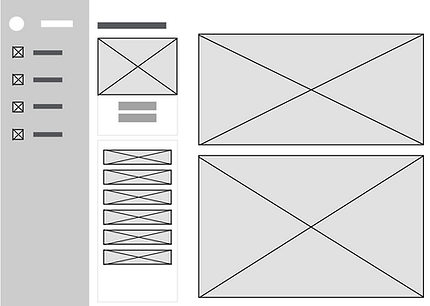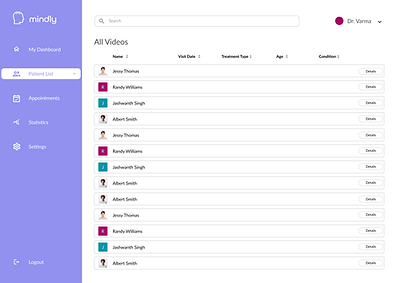Mindly
May 2023 - August 2023
Redesigning of Neurological Disorder Symptom Tracking Platform

Overview
Enhancing the path to precise symptom tracking for neurological disorders by revamping the digital infrastructure of Mindly, an early-stage startup originating at UC Berkeley. Mindly's core mission revolves around the creation of a comprehensive visual database. This database empowers clinicians to accurately monitor symptoms of neurological disorders in correlation with medication and therapy.
My role involved revamping both the clinician-facing website and the patient-facing app. The primary objectives were to:
-
Empower Clinicians: Design a clinician-facing website with powerful tools for data analysis and treatment planning.
-
Simplify Patient Engagement: Create an intuitive app interface for patients to upload video logs, facilitating symptom tracking.
-
Unify Digital Presence: Ensure a cohesive and visually appealing digital experience that aligns with Mindly's mission and sets the stage for a successful pilot with the Autism Center of Northern California.
This project aimed to streamline neurological disorder tracking and enhance Mindly's digital presence for a successful pilot program.

Problem
Mindly's current interface exhibits several issues, including repetitive and unintuitive functions, and usability challenges. Given the healthcare nature of the application, our goal is to create a minimalist and highly functional user interface. This UI should facilitate seamless video uploads, symptom tracking, and data analysis while maintaining a strong focus on user-friendliness.
The urgency of this project is underscored by the need for a streamlined digital healthcare solution. Our objective is to address these pain points by delivering an interface that elevates the user experience, enhances patient-clinician interaction, and ultimately empowers both patients and clinicians in their journey towards accurate neurological disorder tracking and treatment.




Old Screens (swipe)
How might we optimize the Mindly platform to facilitate seamless interaction between clinicians and patients, ensuring efficient symptom tracking and empowering clinicians in the effective treatment of neurological disorders?
User Research
I conducted a series of in-depth interviews with clinicians and researchers specializing in autism and diagnosis. The goal was to understand their current workflow, pain points, and their perspective on the need for a platform like Mindly.
One major challenge is the fragmentation in our workflow. We use several different platforms for various tasks, and it's quite inefficient.

A centralized calendar and appointment management system would be a game-changer. It's crucial for us to be able to schedule and manage appointments seamlessly without the administrative overhead.

We're looking for a 'one-stop-shop' solution, essentially a platform that integrates all the essential functions we need.

It's quite labor-intensive. Right now, we sit down and analyze each video log one by one. Sometimes, we even track symptoms manually, which is a painstaking and time-consuming process. We really need a more efficient way to handle this aspect of our work.

Currently, we don't have easy access to aggregated data and trends. It would be incredibly valuable for our research and decision-making processes if we could get generic statistics and insights drawn from the collective data of all users.

Supporting quotes from the interviews
User Interview Insights
The user research revealed several crucial insights:
-
Clinicians and researchers in the field of autism diagnosis are in need of a centralized platform that streamlines their workflow and integrates multiple functions.
-
Key features such as calendar and appointment management, data insights, and a unified interface were highly sought after.
-
The desire for a 'one-stop solution' underscores the need for Mindly to provide a comprehensive platform that addresses all the pain points identified by users.
Optimizing the Clinician Workflow
Mindly's current website was not fully developed, offering limited functionality for efficient patient management. This includes challenges like inefficient video uploading and analysis, limited data insights, and appointment scheduling.
Heuristic Analysis Highlights:
-
Video Uploading and Analysis: The process of uploading and analyzing patient videos is inefficient and needs improvement.
-
Data Tracking: Clinicians face difficulties in tracking patient progress due to limited data insights.
-
Appointment Management: The underdeveloped system lacks user-friendly tools for scheduling and monitoring appointments.
Low-fidelity Mockups
I created low-fidelity mockup screens based on project requirements and promptly shared them with our clients to initiate collaboration. Their input and feedback at this early stage allowed us to refine the design to better align with their needs, ensuring a more effective clinician workflow for neurological disorder management.
.png)
Landing Page

Dashboard

Teams Page
%20(1).png)
Video Uploading Page
%20(2).png)
Patient's Page

Contacts Page

Statistics Page
.png)
Login
High-fidelity Screens
As we progressed, I transitioned from low-fidelity mockups to high-fidelity screens, incorporating feedback from our clients every two weeks.
Simultaneously, I closely collaborated with a third-party development team responsible for coding the website. This dual approach allowed us to work in tandem, ensuring that the design and development phases were seamlessly integrated. I provided continuous feedback to the developers throughout the process, maintaining open lines of communication until the final website was ready.
.png)
.png)
.png)

Main Pages
%20(3).png)

.png)
Login and post-login Pages

.png)
%20(4).png)
%20(5).png)

Final Solution
The culmination of our efforts resulted in a streamlined and user-centric platform. The final solution offers clinicians and researchers in the field of neurological disorders an efficient and intuitive workflow. It seamlessly integrates appointment management, data tracking, video analysis, and communication, all while providing valuable data insights. This solution not only enhances the efficiency of clinician-patient interactions but also supports research efforts in the field, ultimately advancing the diagnosis and treatment of neurological disorders.
Final website after development (scroll)
Key Takeaways
-
Design, Test, Iterate, Repeat: Throughout this project, I learned the power of a cyclical design process. Continuously refining our designs based on user feedback and collaborating with the team was key to creating a user-friendly platform.
-
Active Collaboration: Actively engaging with clients, stakeholders, and the development team from the project's inception was a critical lesson. Early and transparent communication ensured that everyone shared the same vision and expectations.
-
Medium of Communication: I discovered that visual communication had a significant impact. Sharing design patterns, sketches, and wireframes helped convey ideas effectively and garnered valuable early feedback, fostering a shared understanding among team members.
-
Incorporating Feedback: Regular biweekly feedback sessions with clients allowed us to adapt and improve continuously. This iterative approach was instrumental in tailoring the final product to the specific needs and expectations of clinicians and researchers in the field of neurological disorders.
-
Simultaneous Design and Development: Collaborating closely with the third-party development team was pivotal. My active feedback to the developers throughout the project's lifecycle ensured that design and development were seamlessly integrated, resulting in a cohesive and fully functional website.